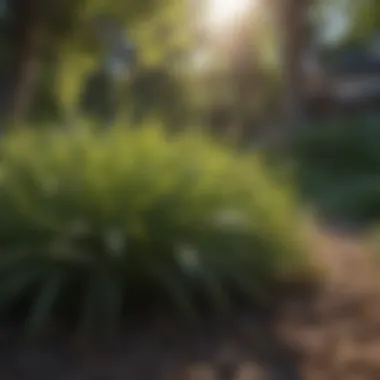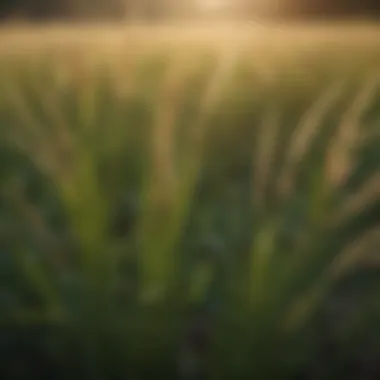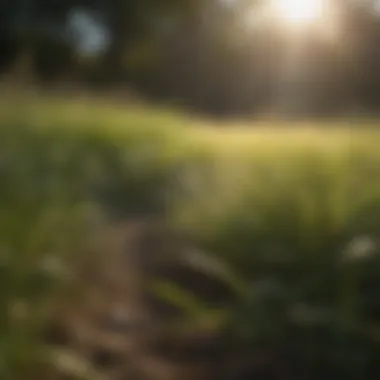Best Warm Season Grasses for Shaded Areas


Overview of the Topic
Definition and Importance
Warm season grasses, defined as grasses that grow best during the warmer months, can face unique challenges when grown in shaded areas. Their growth patterns and adaptability must align with less sunlight to ensure successful development. Understanding the interplay between shade and these grasses is essential for landscape planning and maintenance. The significance of this topic is underscored by the growing interest in sustainable landscaping practices, as owners seek to maximize available space without sacrificing aesthetic appeal.
Current Trends
Currently, there is a rising trend in selecting diverse and resilient grass types suitable for shaded environments. Homeowners and landscape professionals alike are looking at environmentally friendly options that can thrive with less sunlight. This trend reflects a broader movement towards sustainable and biodiversity-rich gardens. Technologies are also emerging that support better shade management such as soil conditioners and organic fertilizers, enhancing the viability of these grasses under challenging conditions.
Key Techniques and Practices
Step-by-Step Guide
Growing warm season grasses in shaded areas requires careful planning and execution. Here is a basic guide to help one get started:
- Choose the Right Grass: Select species like Zoysia or St. Augustine that are more tolerant to shade.
- Soil Preparation: Test soil pH and nutrient levels, amending as necessary with organic matter.
- Seeding or Sodding: Depending on the grass type, either sow seeds in late spring or lay sod in early summer.
- Watering: Ensure proper watering practices, as shaded areas may retain moisture longer.
- Mowing and Maintenance: Regular mowing encourages growth while leaf perennials can help manage light capture.
Tools and Equipment Needed
Certain tools make the process easier. It is important to have:
- Soil testing kit
- Rototiller for soil preparation
- Lawn mower with adjustable height
- Sprinkler system for effective watering
Challenges and Solutions
Common Obstacles
Several obstacles can hinder the growth of warm season grasses in shaded areas. These include:
- Insufficient sunlight
- Competition with tree roots
- Soil compaction
Innovative Solutions
Addressing these challenges involves innovative solutions. For instance, consistent monitoring of sunlight exposure can help adjust planting strategies accordingly. Using shade-tolerant grass varieties reduces competition for nutrients. Maintaining proper soil aeration helps mitigate compaction issues.
"The right grass can transform a shaded space into a vibrant landscape, it takes understanding and care."
Understanding Warm Season Grasses
Warm season grasses are essential in many agricultural practices and landscaping efforts. The significance of understanding these grasses lies in their suitability for warm climates where sunlight is abundant. Knowing how these grasses function can lead to better strategies for lawn care, effective land use, and even ecological benefits.
Defining Warm Season Grasses
Warm season grasses, also known as C4 grasses, thrive in warmer temperatures. They generally grow best when temperatures reach between 80°F and 95°F. Examples include Bermuda grass, Zoysia grass, and Buffalograss. These grasses enter their growth phase in late spring and peak during the summer months. Understanding their definition helps in different agricultural initiatives and landscaping choices.
Growth Characteristics
The growth characteristics of warm season grasses include their ability to establish deep roots and their tolerance to heat and drought. Unlike cool season grasses, which thrive in cooler weather, warm season grasses exhibit a unique physiological adaptation that allows them to conserve water. They utilize a process known as photosynthetic carbon fixation to grow efficiently during hotter conditions.
- Deep Root Systems: These grasses can access water and nutrients deeper in the soil. This characteristic makes them resistant to drought conditions.
- Green Color: Warm season grasses develop their lush green foliage typically in late spring and maintain it through summer before becoming dormant in the fall.
- Growth Rate: During its peak growing season, warm season grasses can recover quickly from damages like foot traffic and pests, thanks to their rapid growth pattern.
Climate Suitability
Warm season grasses are suited for regions that experience hotter summer temperatures and milder winters. Areas in the southern United States, including Texas, Florida, and parts of California, showcase the ideal climate for these grasses. They manage well under various conditions:


- Temperature: These grasses thrive in warmth but may struggle if faced with extreme frost.
- Humidity: They adapt well to varying humidity levels but prefer moderate humidity conditions.
- Soil Type: Warm season grasses can grow in a range of soil types but do best in well-drained, sandy loam soils.
"Understanding warm season grasses is the first step toward cultivating a vibrant landscape that endures through seasonal changes."
The Importance of Shade in Grass Growth
Understanding the role of shade in grass growth is critical for both landscaping professionals and agricultural enthusiasts. Shaded environments present unique challenges that can affect the well-being and performance of warm season grasses. Being aware of these implications is important when planning a lawn or field.
Effects of Shade on Grass Health
Shade can significantly influence grass health in several ways. First, it affects photosynthesis, the primary process through which grasses convert sunlight into energy. When plants are deprived of sufficient light, their growth slows down. This can lead to smaller blades, reduced density, and overall weaker plants. Moreover, shaded grasses may develop elongated stems as they reach for light, which can lead to uneven growth and a less robust lawn.
Another aspect to consider is moisture retention. Shaded areas often retain more moisture compared to sunlit ones, which can encourage fungal diseases and pests. This excessive moisture can result in root rot or other diseases that thrive in damp conditions. It is vital to monitor these areas closely to ensure grass health is maintained.
To mitigate these issues, it is advisable to choose grass varieties that are specifically bred to tolerate shade, such as Zoysiagrass or Fescue. These grasses are more resilient and better equipped to thrive with limited sunlight.
Natural Environments and Shade
Shaded environments naturally occur in various ecosystems such as under trees or near buildings. In these areas, the interplay of light and shadows creates micro-environments that can vary greatly. Understanding these differences is crucial in selecting and maintaining the right grass type.
Different environments can impact the growth patterns of warm season grasses. For instance, grass under a broadleaf tree may experience dappled sunlight whereas grass near a tall building may only receive indirect light.
"The selection of appropriate warm season grasses can greatly influence eco-efficiency and grass health in shaded areas."
Overall, acknowledging the significance of shade is essential. It influences not only the health of individual grasses but also the broader ecological systems that they inhabit.
Understanding the right types of grass to plant in shaded areas is essential for maintaining healthy and aesthetically pleasing landscapes. Warm season grasses adapt uniquely to various light conditions. Selecting the right type can lead to better growth, less maintenance, and enhanced beauty in shaded environments. This section will explore four notable varieties: Bermudagrass, Zoysiagrass, Buffalograss, and Fescue. Each grass type presents specific characteristics, benefits, and ideal growing conditions.
Bermudagrass
Bermudagrass is a popular choice, known for its resilience and ability to tolerate various conditions, including some shade. It is a warm-season perennial that thrives best in full sun, but certain cultivars can withstand partial shade. The grass exhibits quick growth, which fills in bare areas rapidly.
Key Benefits of Bermudagrass:
- Tolerates light foot traffic well.
- Establishes quickly from seed or sod.
- Adaptive to different soil types, given proper drainage.
However, its performance diminishes significantly in heavy shade. For optimal results, Bermudagrass requires adequate sunlight and good soil fertility. Therefore, consider mixing it with more shade-tolerant options if the area has limited daylight.
Zoysiagrass
Zoysiagrass stands out for its adaptability to shade compared to many other warm season varieties. It grows slower initially but forms a dense mat once established. This grass type is also drought-tolerant, making it suitable for varied climates.
Considerations for Zoysiagrass:
- Best suited for moderate to heavy shade.
- Forms a thick carpet that suppresses weeds.
- Requires less frequent mowing because of its slow growth.
Its ability to thrive in shaded environments without significant fertility needs makes Zoysiagrass a practical option. It is a well-rounded choice for homeowners looking to manage lawns with trees or other structures causing shade.
Buffalograss
Buffalograss is an excellent warm season option primarily for low-maintenance lawns. While it thrives in sunny locations, certain cultivars can perform reasonably in partial shade. This grass is known for its drought resistance and lower nutrient needs.
Advantages of Buffalograss Include:
- Very low water requirements after establishment.
- Hardy and durable under various weather conditions.
- Grows well in poor soils.


Buffalograss may require additional care in shaded areas to reach its full potential. It can grow slower without direct sunlight, and mixing it with other grass types may improve aesthetics and cover.
Fescue
Although not strictly a warm season grass, fescue is noteworthy due its adaptability to shaded areas. Tall fescue, in particular, can withstand the heat of summer while providing a lush green lawn in partial shade. This adaptability gives it an edge in settings with mixed sun and shade patterns.
Fescue Characteristics:
- Thrives in cooler temperatures, making it unique among this group.
- Offers moisture retention, reducing watering needs.
- Good for high-traffic areas due to its robust structure.
Incorporating fescue into your grass mixture can provide a green landscape where sunlight is less intense. It can work as an excellent partner with warm season grasses, balancing overall health and aesthetic appeal.
Selecting the Right Grass Type
Choosing the correct type of warm-season grass is crucial when planning a landscape that includes shaded areas. The various species have unique characteristics that enable them to adapt to less than ideal light conditions. Understanding these differences can help ensure a thriving lawn that meets aesthetic and practical needs. A well-chosen grass type can promote better growth, reduce maintenance efforts, and improve overall resilience against environmental stresses.
Factors such as shade levels and soil condition play a significant role in this decision-making process. Assessing the amount of sunlight that an area receives throughout the day will help identify which grass varieties will grow best there. With careful consideration, you can select a grass type that not only withstands limited light but also complements the surrounding environment.
Assessing Shade Levels
Evaluating the level of shade in a specific area is the starting point for selecting the right grass type. Shades can be categorized into three main types: full shade, partial shade, and open areas. Each category will dictate the kind of grass that can be successfully established.
- Full Shade: Areas that receive less than four hours of direct sunlight each day fall into this category. Grass varieties like Fescue are highly adaptable in such conditions and can maintain healthy growth even with limited light access.
- Partial Shade: These areas receive between four to six hours of sun. Zoysiagrass performs well here. It typically thrives in dappled light conditions and provides a durable lawn surface.
- Open Areas: These places receive more than six hours of sunlight and can accommodate a wider range of grass types like Bermudagrass. Assessing shade levels accurately will guide successful implementation.
Using tools like a sun calculator can help determine shade levels effectively. Furthermore, observing the site through different seasons can provide insights into how light availability might change.
Soil Considerations
Soil quality cannot be overlooked when selecting the right grass type for shaded regions. Different grasses have varying tolerances and requirements in terms of soil nutrients and texture. The following considerations should be kept in mind:
- pH Levels: Most warm-season grasses prefer a soil pH in the range of 6.0-7.0. Soil tests can help determine how to adjust pH to make it suitable for the chosen grass type.
- Texture and Compaction: Compacted soils can limit root expansion, affecting growth. Loamy and well-aerated soils favor healthy development. Using organic matter can improve soil structure.
- Nutrient Availability: A well-balanced soil provides essential nutrients needed for grass health. Testing for nitrogen, phosphorus, potassium, and other micronutrients is crucial. Based on soil test results, you can apply fertilizers tailored to the grass type selected.
Maintenance Practices for Warm Season Grasses
Maintaining warm season grasses like Bermudagrass, Zoysiagrass, and Buffalograss in shaded environments presents unique challenges. Proper maintenance practices can significantly influence the health and longevity of these grasses. Attention to watering, fertilization, and mowing techniques are particularly vital. These practices not only enhance grass growth but also improve the ecological balance in the area.
Watering Requirements
Watering is one of the most critical aspects of maintenance for warm season grasses. In the shade, these grasses may not receive adequate rainwater due to the canopy above. Therefore, regular watering is essential.
A general rule is to provide about one inch of water per week, either from precipitation or irrigation. However, this may vary depending on specific weather conditions.
- Frequency: Watering two to three times a week is often sufficient, adjusting based on moisture levels and rainfall.
- Method: Deep watering promotes healthy root growth. This means allowing water to penetrate the soil rather than watering frequently for short durations.
- Timing: Early morning is the best time to water to minimize evaporation losses.
Maintaining adequate moisture levels will help the grasses survive in shaded environments where soil drying out can stunt growth.
Fertilization Needs
Fertilization plays a crucial role in sustaining the health of warm season grasses. In shaded areas, grass may struggle to obtain sufficient nutrients. Thus, understanding specific fertilization needs becomes paramount.
- Type of Fertilizer: Use slow-release fertilizers with a balanced ratio of nitrogen, phosphorus, and potassium. This balance encourages steady growth without causing nutrient burn.
- Timing: Fertilize in early spring and again in late summer for optimal results. This timing aligns with the natural growth cycles of warm season grasses.
- Application Methods: Evenly distributing fertilizer across the lawn ensures all grass plants have access to nutrients. Avoid heavy applications that can lead to runoff and contamination of nearby areas.
Mowing Techniques
Mowing is another vital aspect of maintaining warm season grasses in shaded regions. The height at which grass is mowed influences its ability to photosynthesize, especially in low-light conditions.


- Mower Height: Keep the mowing height between two and a half to three inches. This height helps maximize leaf surface area and allows for better light absorption.
- Mowing Frequency: Mow regularly during the growing season. In shaded areas, mowing less frequently may be necessary as the grass grows slower than in full sunlight.
- Mower Sharpness: Use sharp mower blades to prevent tearing the grass blades. Clean cuts promote better healing and reduce vulnerability to disease.
Proper maintenance practices are essential for the resilience of warm season grasses in shaded areas.
By focusing on these vital care aspects, one can create a lush and healthy green space, even in less than ideal lighting conditions.
Challenges with Warm Season Grasses in Shaded Areas
In shaded environments, warm season grasses encounter unique challenges that can significantly impact their growth and overall health. Understanding these challenges is essential for farmers and landscaping enthusiasts aiming to cultivate these grasses effectively. This section delves into two primary issues: pest and disease risks, as well as competition with other plants.
Pest and Disease Risks
Warm season grasses are not immune to the threats posed by pests and diseases. While sunlight plays a crucial role in the health of any plant, shaded areas can create a more favorable environment for specific pest populations. For instance, grub worms and nematodes may proliferate in areas with poor drainage and less air circulation, often associated with shade.
In addition to pests, diseases such as dollar spot or brown patch can thrive in humid, shady conditions. Proper watering practices and maintaining a healthy soil balance are critical to mitigate these risks. Monitoring grass health regularly and taking timely action against visible signs of issues can prevent minor problems from escalating.
"Understanding local pest populations and their life cycles can be beneficial in developing effective control measures."
Competition with Other Plants
Shaded areas are often characterized by the presence of other vegetation, including various weeds and ornamental plants. These competing species can hinder the growth of warm season grasses. For example, tall fescue and various types of clover are often aggressive in shaded conditions, outpacing warm season grasses for nutrients and space.
To combat this competition, selecting the right species of warm season grasses is vital. Certain varieties, like Zoysiagrass, have robust growth habits that allow them to compete effectively in shaded areas. Additionally, proper soil preparation and weed management practices must be implemented to reduce competition for essential resources.
Ecological Benefits of Warm Season Grasses
The ecological benefits of warm season grasses, particularly in shaded areas, are significant and multifaceted. These grasses not only adapt well to less-than-optimal light conditions but also contribute positively to various environmental factors. Understanding these benefits is crucial for agricultural enthusiasts and professionals wishing to make informed decisions about their landscapes.
Biodiversity Enhancement
Warm season grasses play a vital role in enhancing biodiversity in various ecosystems. When planted in shaded areas, they provide habitat for numerous species, including pollinators such as bees and butterflies. This habitat fosters a more resilient ecosystem by creating a balanced environment that supports various forms of life.
Additionally, warm season grasses can promote the presence of beneficial insects that help control pest populations. These grasses often cohabitate with other flora, forming complex communities that can attract diverse wildlife. Establishing these grasses in shaded landscapes encourages a diverse ecological web, which is essential for sustaining healthy ecosystems.
"Diverse ecosystems are more productive and resilient, and warm season grasses are integral to maintaining this diversity."
Soil Health Improvement
Another significant ecological benefit of warm season grasses is their capability to improve soil health. These grasses have deep root systems that help prevent soil erosion, especially in shaded areas where other plants might struggle. The roots contribute to soil structure, increasing the soil's ability to hold water and nutrients.
Moreover, as warm season grasses grow, they contribute organic matter to the soil. This organic material enhances soil fertility and promotes the proliferation of beneficial soil microorganisms. Healthier soil not only supports plant growth but also plays a critical role in carbon sequestration, helping to mitigate climate change effects.
In summary, the adoption of warm season grasses in shaded environments efficiently promotes biodiversity and improves soil health. This dual benefit underscores their importance in landscape management, especially for those looking to create sustainable and resilient environments.
Closure
Utilizing warm season grasses adapted to shade can lead to enhanced garden aesthetics and healthier turf. Practitioners can reduce maintenance costs and promote biodiversity while ensuring that their landscape remains vibrant. Moreover, the ecological benefits that these grasses provide cannot be understated. Improved soil health and biodiversity can be critical in maintaining an ecosystem that supports various plant and animal life.
Summary of Key Points
- Warm season grasses can thrive in partial to full shade.
- Selection is key; knowing the specific types, like Zoysiagrass and Fescue, can aid in effective landscaping.
- Maintenance practices differ; unique watering and fertilization may apply comparatively to sun-loving grasses.
- These grasses can enhance biodiversity and improve soil health, providing ecological benefits.
Future Considerations
Going forward, it is essential to continue researching the adaptability of warm season grasses under shifting climate conditions. As new species are cultivated or existing varieties bred for improved shade tolerance, this knowledge will be fundamental to future agricultural practices.
Additionally, as urban areas expand and shade from buildings becomes more common, the demand for these grasses is likely to increase. Homeowners and landscapers should consider integrating these plants into their designs. Monitoring the interactions between warm season grasses and other vegetation can yield insights for maximizing ecosystem health. As scientific exploration of plant adaptability deepens, the potential applications in farming and landscaping are immense, inviting more innovation for shaded environments.
"Understanding diverse grass types for shade not only enhances aesthetics but also the ecological quality of green spaces."
Engaging with local horticultural advisories and utilizing pertinent resources such as Wikipedia, Britannica, and gardening forums on Reddit can provide further insights and community engagement.



